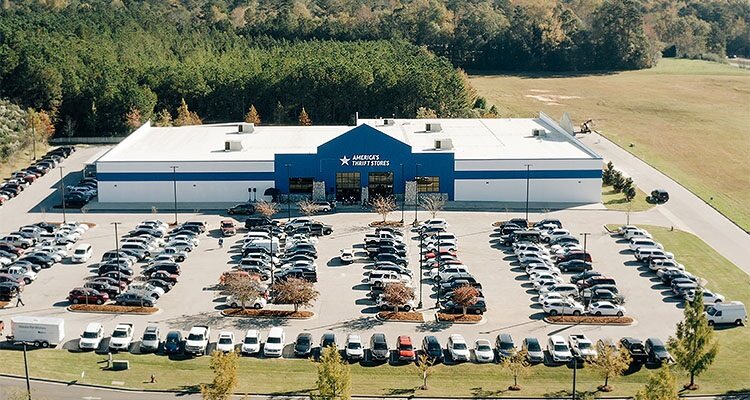
Growth, sustainability, and community continue to be the leading reasons for America’s Thrift Stores’ success
You’ll find America’s Thrift Stores in the heart of America’s Southern states, where the business has been working hard to re-energize the thrift industry for the last 38 years. With 28 stores across five states, including Georgia, Tennessee and Alabama, the company has become a formidable player in the retail landscape, boasting an impressive $100 million in revenue and a mission-driven approach.
It has been about two years since we last spoke with Ken Sobaski, the company’s CEO. This year, we caught up with Ken to learn how the business has fared over the last 24 months, and how it continues to reshape sustainability in the thrifting sector, alongside expanding its community initiatives.
What sets America’s Thrift Stores apart is not only its business model, but also its unwavering commitment to giving back. Ken outlines the four pillars of the company’s mission: “We’re a complex business. Our mission as a company is To Give Back, and we do that in four ways. The first is obviously through the donations we collect, and the fact that those collections prevent waste from going to landfill. Secondly, we partner with charities. We give over $3 million annually to great charities like Make A Wish and Children’s Miracle Network, through Children’s Healthcare of Atlanta (CHoA). The third is through the jobs we create as a fast-growing company. We’ve added over 700 jobs since the fall of 2019. Lastly, the values our company sells in each store every day, have a positive impact on what each store means to the community. There are customers that visit their local store routinely to clothe their kids or outfit their homes,” shares Ken.
company’s mission: “We’re a complex business. Our mission as a company is To Give Back, and we do that in four ways. The first is obviously through the donations we collect, and the fact that those collections prevent waste from going to landfill. Secondly, we partner with charities. We give over $3 million annually to great charities like Make A Wish and Children’s Miracle Network, through Children’s Healthcare of Atlanta (CHoA). The third is through the jobs we create as a fast-growing company. We’ve added over 700 jobs since the fall of 2019. Lastly, the values our company sells in each store every day, have a positive impact on what each store means to the community. There are customers that visit their local store routinely to clothe their kids or outfit their homes,” shares Ken.
Stellar success
In addition to the business’ impressive community commitment, another aspect gaining traction is ATS’ emerging ecommerce business. The online shopping experience has become integral in society’s shopping habits, and the company is especially interested in leveraging opportunities in the recycling sector. “We generally keep things on sale at our stores for three-to-five weeks. Then, if they don’t sell, they go into recycling markets. Now, we can put them online to sell in the form of mystery boxes or micro-bales, for example. Resellers will buy those items, and sell them on their own websites, like Etsy or Shopify, or maybe they have a small mom-and-pop thrift store as well. This allows us to sell things we don’t have a recycling market for, like high heels or winter clothing for example,” Ken says. The company has three separate online platforms: shopATS.com, eBay, and America’s Thrift Supply for wholesale; they also sell second-hand books on Amazon.
Ken highlights that the company boasts its own supply chain and logistics unit to facilitate these processes, which collects nearly 60 million pounds of donations annually. “Our stores are not just retail spaces; they function as processing plants that process the myriad donations we receive from five different sources. We then sort, grade and price those donations to ensure fresh stock goes to the sales floor daily. They also have a wholesale recycling business that ships unsold items internationally.”
To further emphasize how well the company has done over the last two years, Ken delves into its growth trajectory, and the numbers speak for themselves. “Over the last three years, our sales have grown more than 75 percent. We’ve added 11 stores and launched three online businesses. Despite the challenges that came from the pandemic, we’ve achieved record annual sales levels in 16 of our long-standing stores.”
 A new store every day
A new store every day
Part of the reason why the company has been so successful is its unique shopping experience. Ken is proud to share the transformation initiated through the ‘Bright and Fresh’ program, which is aimed at making existing stores feel like new locations. “Our stores are not your typical thrift stores. When we open new ones, we envision them resembling TJ Maxx or Ross – bright, organized, and inviting. We want people to walk in and realize, ‘It’s Not Your Mama’s Thrift Store’,” Ken remarks, nudging at the business’ driving ethos. The company’s emphasis on variety, selection, and constant inventory turnover also plays a pivotal role in distinguishing it from competitors, as its tagline – Where it’s a new store every day! – suggests. Ken states this is achieved through a data-driven approach for managing processing and floor rotation to maintain freshness and cater to its most loyal high-frequency shoppers.
The conversation then turns to sustainability, which is gaining traction across all industries, let alone retail. Ken stipulates that this topic is essentially the tailwinds propelling thrift, and jokes that as ‘thrifting’ slowly becomes as widely used as ‘googling’, the company has witnessed a significant increase in younger customers. “Yes, thrifting is inherently sustainable as it steers away from fast-fashion production. However, there’s more to it. The younger generations, especially Gen Z, are drawn to thrift shopping not just for sustainability, but for the fashion and individuality it offers. Gen Z customers have gone from being eight percent to nearly 18 percent of our total sales, as a consequence of the sustainable nature of our business model as well as being driven by the individuality of that population group – they want to create their own look and a thrift store allows them to do that.
“Now, that’s not to say there aren’t challenges in the thrift sector, because, despite its pros, there are also cons. As the economy struggled and inflation rose, it’s been tougher to collect donations. When inflation goes up, disposable income goes down, people are buying less new things, and when they buy less new things, they donate less things. So, yes, the industry is incredibly sustainable. However, its success is also dependent on the economy’s success,” Ken notes.
People and planet
Looking ahead, he shares plans for continued growth, emphasizing new store openings and expanding the awareness and presence of its three online trading avenues. The company aims to leverage the positive trends in thrifting, capitalize on the popularity of online platforms, and continue positively impacting the communities it serves.
To sustain this vision, Ken emphasizes the critical role of America’s Thrift Stores’ people. “To grow as a company, we must grow with our people. We’re investing in attracting and developing talent, with almost 70 percent of new supervisor or management roles filled internally. We have a robust learning management system in place to enhance our employees’ skills,” he says. Leadership development is also important in a people-intensive business, as each manager oversees a team of 50 to 100 individuals.
As the conversation concludes, it is evident that America’s Thrift Stores, under the leadership of Ken Sobaski, is not just navigating the thrift landscape but shaping its future. The business stands poised for a thrift revolution that goes beyond the items on its shelves.